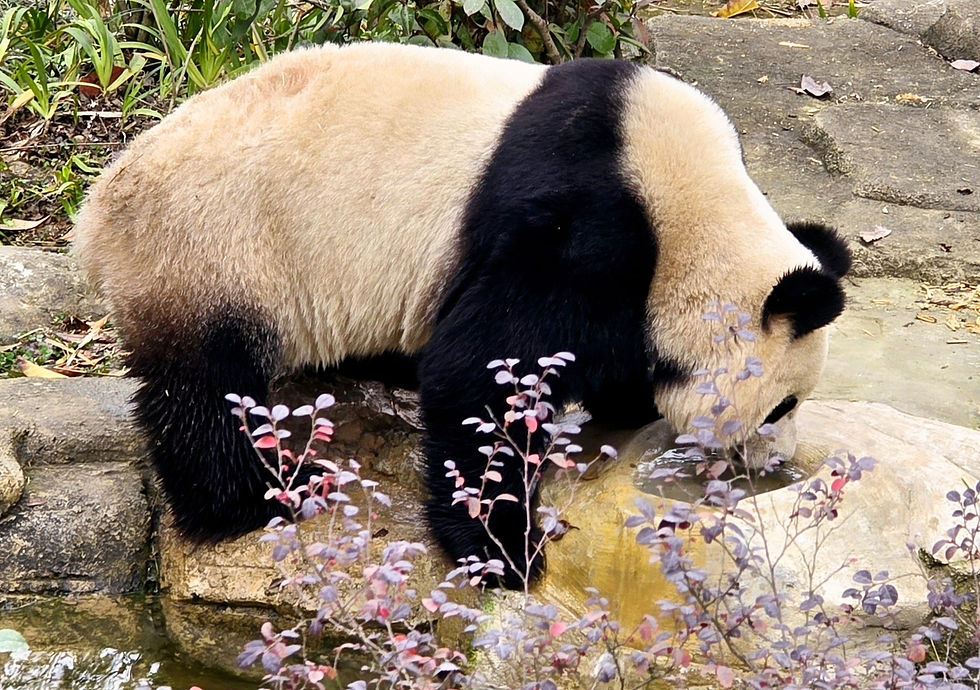Chengdu Panda Research Base - China’s National Treasure
- Shannon
- Sep 4
- 3 min read
A Quiet Sanctuary for One of the World’s Rarest Icons
The "Chengdu Research Base of Giant Panda Breeding" is one of the most prominent and respected facilities in the world, dedicated to the conservation and research of the Giant Panda. Established in 1987, the goal of this research base was to increase the panda population and ensure their survival in the wild. At the time, only 1000 giant pandas remained in the wild.

In Chinese culture, Pandas are sacred and revered as symbols of peace and harmony
Located in Chengdu, the capital of Sichuan Province, the base was created to tackle critical issues threatening their survival, including habitat loss, limited genetic diversity and low reproduction rates. The facility has made great strides in understanding panda behaviour and improving reproduction techniques. Over the past 40 years, many of the cubs born at this facility were released back into the wild or sent to other research centres across the world.
Another essential aspect of the research base is the conservation effort into habitat restoration. The Chinese Government and local communities are working to preserve & restore natural habitats and promote sustainable development practises within the protected bamboo forests which are spread throughout the mountains. They also heavily promote public engagement and education.
In ancient Chinese mythology, pandas were seen to bridge the gap between humans and nature, acting as peaceful guardians of the mountains and its forests
One of the biggest challenges for pandas is their low reproduction rate. Female pandas are only in heat for 2-3 days per year. This limited window adds to the complexity of their breeding efforts, especially in the wild where there are fewer mating opportunities. After mating, they experience a phenomenon called delayed implantation, fertilised eggs float around the reproductive tract for several weeks. They also have a very short gestation period of about 5 months, so babies are born remarkably small and extremely underdeveloped. Pandas spend up to 12 hours a day eating bamboo, which makes up 99% of their diet. While they may appear clumsy and playful, they are capable of problem solving and show emotional intelligence during social interactions, especially with their babies.
Mothers will care for their babies for up to 2 years, ensuring that the cub is equipped with all the skills required to survive on its own
While significant progress has been made in the conservation of giant pandas, they remain extremely vulnerable from climate change and habitat fragmentation. In recent years, the Chinese government has implemented many measures to protect their national emblem, including the establishment of national parks and wildlife corridors to connect isolated panda populations in the wild. As of 2025, it is estimated that 1800 wild giant pandas now live in the protected mountainous regions of Sichuan, Gangsu and Shaanxi.

The Chengdu Panda Research Base is celebrated as one of China’s National Treasures
🗺️ Location
1375 Panda Avenue, Chenghua District, Chengdu City, Sichuan Province, China
🚆 How to get there
Tourists can take Metro Line 10, transfer to Line 3 at Tai Ping Yuan Station and get off at Panda Avenue Station (Xiongmao Dadao) and get out via Exit A. Walk to Panda Avenue Bus Station, take Panda Express Line 5, and get off at Chengdu Panda Base Station. Walk about 250 meters to get to the entry. Or you can take a taxi, which will take about 35 minutes.
⭐ Attraction Info
The Research Base is open everyday from November 1st to February 28th (except Tuesdays) between 8am - 12pm and 12pm - 4:30pm and from March 1st to October 31st except Tuesdays) between 7:30am - 12pm and 12pm - 5pm. Tickets are actually free but all visitors are required to make a reservation online. ID cards or passports must be presented at the entry gates. A real-time passenger flow control system is applied. When the number of visitors exceeds 200, the gate will automatically close, which means visitors need to wait outside for the next round of entry. This park is huge and you will need at least 2-3 hours to walk around. Ask specifically where the baby enclosures are, as signage isn't totally clear.
🔗Official Website
成都大熊猫繁育研究基地

Thanks for reading Chengdu Panda Research Base - China’s National Treasure. Check out more awesome destinations here!




















